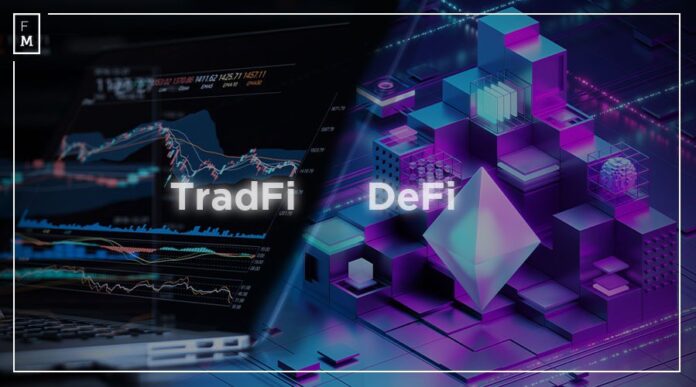Finance has many new words that can be confusing. One word people use a lot now is TradFi. In this post, we will explain what TradFi means, why it is important, and how it affects things.

- What is TradFi?
- How Finance Has Changed: From Traditional to Digital
- Comparing Traditional and Digital Finance
- Traditional Finance
- Digital Finance
- How Old Money and New Money Mix
- Using Robo-Brains to Mash Money Methods
- Things That Talk and Move Money
- Simple Money Trades Using Computer Codes
- Old Money Systems Are Changing
- Old and New Money Systems Working Together
- The Next Version of Old Money Systems
- Making Money Simple for Everyone
- Cryptocurrencies are Changing Money
- Overcoming Hurdles in Digital Finance
- Working Together is Key
- Making Finance Easy for Everyone
- Traditional Finance Goes Digital
- Following the Rules of TradFi 2.0
- Finding the Right Balance
- Navigating Regulatory Uncertainty in Digital Finance
- Collaborative Approaches to Regulatory Compliance
- The Role of RegTech in Compliance
- Building Trust Through Transparency and Accountability
- Adapting to Evolving Regulatory Landscape
- Conclusion
What is TradFi?
TradFi stands for Traditional Finance. It refers to the usual financial system that has been around for a long time. This includes banks, credit unions, insurance companies, and other traditional financial businesses. These follow rules set by governments and finance authorities.
How Finance Has Changed: From Traditional to Digital
As technology gets better, finance changes a lot. Things like cryptocurrency, DeFi (Decentralized Finance), AI (Artificial Intelligence), Machine Learning, IoT (Internet of Things), and Blockchain have changed how we use financial services.
Comparing Traditional and Digital Finance
Traditional Finance
Traditional finance relies on middlemen like banks and financial firms to help with transactions, investments, and services. It works in a central system with rules set by regulatory bodies.
Digital Finance
Money works in two ways. Usual banking follows old rules. It uses banks and firms as go-betweens. Digital cash works differently. It uses computers to move money without middle-people. No banks needed. Digital cash gives more control to normal folks.
How Old Money and New Money Mix
Old banking and digital cash seem different. But they are coming together now. Blending styles is called TradFi 2.0. It takes good parts of old banking. But it adds new computer tricks too. This blend can make both kinds better.
Using Robo-Brains to Mash Money Methods
Smart computer brains help make old banking new. AI reads data fast. It sees trends quickly. Banks use AI to choose loans or do trades. These robo-minds bring old and new cash modes together smoothly.
Things That Talk and Move Money
Internet-joined gizmos reshape cash flow. They sense what’s happening. Then gear moves funds as needed automatically. Smart cars sense low gas. They pay for fuel by chatting with pumps. These chat-boxes skip old payment hassle. More IoT tools change how all people use money.
Simple Money Trades Using Computer Codes
The base of digital money is a special computer code called Blockchain. This code allows money to be traded safely and openly. Everyone can see the trades. No one can change past trades. Blockchain handles cryptocurrency trades and smart contracts. Smart contracts are computer programs that do money trades automatically.
Old Money Systems Are Changing
Old money systems (TradFi) are not going away. But they are getting new technology. AI, machine learning, internet of things (IoT), and Blockchain help old money systems. With new tech, old money systems can keep working well.
Old and New Money Systems Working Together
Old money systems (TradFi) and new digital money need to work together. Old money systems have rules and safety. Digital money has new ideas and easy access. Both systems need each other to be better.
The Next Version of Old Money Systems
TradFi 2.0 means old money systems changing with new tech. Old systems use AI, machine learning, IoT, and Blockchain. This helps old systems do new things better and faster. Old money systems can grow and compete with digital money systems using new tech.
Making Money Simple for Everyone
DeFi platforms are using blockchain to offer money services. They don’t need banks or middlemen. This makes it easier for people without bank accounts to access money tools. Many people around the world cannot use banks.
Cryptocurrencies are Changing Money
Cryptocurrencies are challenging traditional money systems. Some think they might replace regular money. Others see them as an opportunity to improve finance. As rules and use increase, cryptocurrencies will likely play a big role in money’s future.
Overcoming Hurdles in Digital Finance
Despite benefits, there are challenges with digital finance. Laws are unclear. Cybercrime is a threat. The technology has limits. Banks must address these issues to fully utilize digital finance.
Working Together is Key
To tackle challenges, banks, startups, and tech firms must cooperate. By combining skills and networks, they can drive innovation. They can build trust and a more inclusive financial system. Collaboration is essential for success.
Making Finance Easy for Everyone
As we move into the digital age, we must help people learn about money. Clear information and resources teaching finance skills are key. This builds trust and promotes good money habits.
Traditional Finance Goes Digital
In the future, traditional finance will blend with digital finance. Banks and financial firms will use technology more. This will make services faster, cheaper, and better for customers. To succeed, these companies must be flexible and forward-thinking as finance changes.
Following the Rules of TradFi 2.0
As traditional and digital finance merge, it’s important to follow the rules that keep the industry stable, secure, and fair for consumers. These regulations are complex but crucial.
Finding the Right Balance
For traditional financial firms, one big challenge is balancing new ideas with following regulations. Innovation helps companies grow and compete. But they must always obey strict finance rules.
Navigating Regulatory Uncertainty in Digital Finance
The rapidly evolving nature of digital finance presents unique challenges for regulators and policymakers. Emerging technologies such as Blockchain, cryptocurrency, and DeFi often outpace the development of regulatory frameworks, leading to uncertainty and ambiguity.
Collaborative Approaches to Regulatory Compliance
To address these challenges, collaboration between regulators, financial institutions, and technology providers is essential. By working together, stakeholders can develop comprehensive regulatory frameworks that foster innovation while safeguarding against risks such as money laundering, fraud, and market manipulation.
The Role of RegTech in Compliance
Regulatory Technology (RegTech) is another area of innovation that is gaining momentum in the financial industry. By leveraging technologies such as AI and Machine Learning, RegTech solutions automate compliance processes, streamline regulatory reporting, and enhance risk management capabilities.
Building Trust Through Transparency and Accountability
In an increasingly digital and interconnected world, transparency and accountability are paramount. Financial institutions must be transparent about their practices, policies, and regulatory compliance efforts to build trust with consumers, investors, and regulators alike.
Adapting to Evolving Regulatory Landscape
As regulatory frameworks continue to evolve, financial institutions must remain agile and adaptable. Keeping abreast of regulatory changes, investing in compliance infrastructure, and fostering a culture of compliance are essential for navigating the ever-changing regulatory landscape.
Conclusion
The traditional financial system has been around for a long time. It has helped economies run smoothly. But now, new digital technologies are emerging. Things like cryptocurrency, DeFi, AI, Machine Learning, IoT, and Blockchain. These new technologies are changing how finance works. The lines between traditional and digital finance are blurring. As this new era of TradFi 2.0 arrives, financial institutions must adapt. They need to use these new technologies. This will help them meet the changing needs of consumers and businesses. Financial institutions must innovate and embrace technology.

